Human Intervention–Induced Changes in the Characteristics of the Turbidity Maximum Zone and Associated Mouth Bars in the Yangtze Estuary
Abstract
:1. Introduction
2. Material and Methods
2.1. Data Collection
2.2. Methods
3. Results
3.1. Characteristics of the Dynamic Process of the TMZ
3.1.1. Salt Intrusion and Its Seasonal Variation in the TMZ
3.1.2. Null Points and Their Seasonal Migration in the TMZ
3.1.3. Seasonal Variation in Riverine Dynamics and Its Impact on the TMZ
3.2. Recent Changes in the Dynamic Process of the TMZ under Human Interventions
3.2.1. Changes in the SSC in the TMZ
3.2.2. Changes in the Location of the TMZ
3.2.3. Changes in the Bathymetry of Mouth Bars in the TMZ
4. Discussion
4.1. Contribution of Declined Riverine Sediment Input to Variations in SSC in the TMZ
4.2. Effects of Local Human Interventions on the TMZ
4.3. Linkage between Local Human Interventions, TMZ Migration, and Mouth Bar Evolution
5. Conclusions
Author Contributions
Funding
Institutional Review Board Statement
Informed Consent Statement
Data Availability Statement
Conflicts of Interest
References
- Mitchell, S. Turbidity maxima in four macrotidal estuaries. Ocean Coast. Manag. 2013, 79, 62–69. [Google Scholar] [CrossRef]
- Li, J.; Zhang, C. Sediment resuspension and implications for turbidity maximum in the Changjiang Estuary. Mar. Geol. 1998, 148, 117–124. [Google Scholar] [CrossRef]
- Billy, J.; Chaumillon, E.; Féniès, H.; Poirier, C. Tidal and fluvial controls on the morphological evolution of a lobate estuarine tidal bar: The Plassac Tidal Bar in the Gironde Estuary (France). Geomorphology 2012, 169–170, 86–97. [Google Scholar] [CrossRef]
- Fan, H.; Huang, H.; Zeng, T.Q.; Wang, K. River mouth bar formation, riverbed aggradation and channel migration in the modern Huanghe (Yellow) River delta, China. Geomorphology 2006, 74, 124–136. [Google Scholar] [CrossRef]
- Chaumillon, E.; Féniès, H.; Billy, J.; Breilh, J.-F.; Richetti, H. Tidal and fluvial controls on the internal architecture and sedimentary facies of a lobate estuarine tidal bar (The Plassac Tidal Bar in the Gironde Estuary, France). Mar. Geol. 2013, 346, 58–72. [Google Scholar] [CrossRef]
- Allen, G.P.; Sauzay, G.; Castaing, P. Transport and deposition of suspended sediment in the Gironde Estuary, France. In Estuarine Processes; Wiley, M., Ed.; Academic Press: Cambridge, MA, USA, 1977; pp. 63–81. [Google Scholar]
- Defontaine, S.; Sous, D.; Morichon, D.; Verney, R.; Monperrus, M. Hydrodynamics and SPM transport in an engineered tidal estuary: The Adour river (France). Estuar. Coast. Shelf Sci. 2019, 231, 106445. [Google Scholar] [CrossRef] [Green Version]
- Wu, J.; Liu, J.T.; Wang, X. Sediment trapping of turbidity maxima in the Changjiang Estuary. Mar. Geol. 2012, 303–306, 14–25. [Google Scholar] [CrossRef]
- Asp, N.; Gomes, V.; Schettini, C.; Souza-Filho, P.; Siegle, E.; Ogston, A.; Nittrouer, C.; Silva, J.; Nascimento, W.; Souza, S.; et al. Sediment dynamics of a tropical tide-dominated estuary: Turbidity maximum, mangroves and the role of the Amazon River sediment load. Estuar. Coast. Shelf Sci. 2018, 214, 10–24. [Google Scholar] [CrossRef]
- Deloffre, J.; Lafite, R.; Lesueur, P.; Verney, R.; Lesourd, S.; Cuvilliez, A.; Taylor, J. Controlling factors of rhythmic sedimentation processes on an intertidal estuarine mudflat—Role of the turbidity maximum in the macrotidal Seine estuary, France. Mar. Geol. 2006, 235, 151–164. [Google Scholar] [CrossRef]
- Talke, S.; de Swart, H.; Schuttelaars, H. Feedback between residual circulations and sediment distribution in highly turbid estuaries: An analytical model. Cont. Shelf Res. 2009, 29, 119–135. [Google Scholar] [CrossRef] [Green Version]
- Toublanc, F.; Brenon, I.; Coulombier, T. Formation and structure of the turbidity maximum in the macrotidal Charente estuary (France): Influence of fluvial and tidal forcing. Estuar. Coast. Shelf Sci. 2016, 169, 1–14. [Google Scholar] [CrossRef]
- Uncles, R.; Stephens, J.; Harris, C. Runoff and tidal influences on the estuarine turbidity maximum of a highly turbid system: The upper Humber and Ouse Estuary, UK. Mar. Geol. 2006, 235, 213–228. [Google Scholar] [CrossRef]
- Wolanski, E.; King, B.; Galloway, D. Dynamics of the turbidity maximum in the Fly River estuary, Papua New Guinea. Estuar. Coast. Shelf Sci. 1995, 40, 321–337. [Google Scholar] [CrossRef]
- Anthony, E.J.; Brunier, G.; Besset, M.; Goichot, M.; Dussouillez, P.; Nguyen, V.L. Linking rapid erosion of the Mekong River delta to human activities. Sci. Rep. 2015, 5, 14745. [Google Scholar] [CrossRef] [PubMed] [Green Version]
- Yang, S.L.; Xu, K.; Milliman, J.D.; Yang, H.F.; Wu, C.S. Decline of Yangtze River water and sediment discharge: Impact from natural and anthropogenic changes. Sci. Rep. 2015, 5, 12581. [Google Scholar] [CrossRef]
- Blum, M.D.; Roberts, H.H. Drowning of the Mississippi Delta due to insufficient sediment supply and global sea-level rise. Nat. Geosci. 2009, 2, 488–491. [Google Scholar] [CrossRef]
- Hodoki, Y.; Murakami, T. Effects of tidal flat reclamation on sediment quality and hypoxia in Isahaya Bay. Aquat. Conserv. Mar. Freshw. Ecosyst. 2006, 16, 555–567. [Google Scholar] [CrossRef]
- van der Wal, D.; Pye, K.; Neal, A. Long-term morphological change in the Ribble Estuary, northwest England. Mar. Geol. 2002, 189, 249–266. [Google Scholar] [CrossRef]
- van Maren, D.; Vroom, J.; Fettweis, M.; Vanlede, J. Formation of the Zeebrugge coastal turbidity maximum: The role of uncertainty in near-bed exchange processes. Mar. Geol. 2020, 425, 106186. [Google Scholar] [CrossRef]
- Kim, T.; Choi, B.; Lee, S. Hydrodynamics and sedimentation induced by large-scale coastal developments in the Keum River Estuary, Korea. Estuar. Coast. Shelf Sci. 2006, 68, 515–528. [Google Scholar] [CrossRef]
- Schulz, E.; Grasso, F.; Le Hir, P.; Verney, R.; Thouvenin, B. Suspended Sediment Dynamics in the Macrotidal Seine Estuary (France): 2. Numerical Modeling of Sediment Fluxes and Budgets Under Typical Hydrological and Meteorological Conditions. J. Geophys. Res. Ocean. 2018, 123, 578–600. [Google Scholar] [CrossRef] [Green Version]
- McSweeney, J.M.; Chant, R.J.; Sommerfield, C.K. Lateral variability of sediment transport in the Delaware Estuary. J. Geophys. Res. Ocean. 2016, 121, 725–744. [Google Scholar] [CrossRef] [Green Version]
- Teng, L.; Cheng, H.; de Swart, H.; Dong, P.; Li, Z.; Li, J.; Wang, Y. On the mechanism behind the shift of the turbidity maximum zone in response to reclamations in the Yangtze (Changjiang) Estuary, China. Mar. Geol. 2021, 440, 106569. [Google Scholar] [CrossRef]
- Alebregtse, N.; De Swart, H. Effect of river discharge and geometry on tides and net water transport in an estuarine network, an idealized model applied to the Yangtze Estuary. Cont. Shelf Res. 2016, 123, 29–49. [Google Scholar] [CrossRef]
- Dai, Z.; Chu, A.; Li, W.; Li, J.; Wu, H. Has suspended sediment concentration near the mouth bar of the Yangtze (Changjiang) Estuary been declining in recent years? J. Coast. Res. 2013, 29, 809–818. [Google Scholar] [CrossRef]
- Wei, W.; Dai, Z.; Mei, X.; Liu, P.; Gao, S.; Li, S. Shoal morphodynamics of the Changjiang (Yangtze) estuary: Influences from river damming, estuarine hydraulic engineering and reclamation projects. Mar. Geol. 2017, 386, 32–43. [Google Scholar] [CrossRef]
- Li, J.; He, Q.; Zhang, C. A study on sediment deposition and resuspension in the mouth bar area of the Changjiang River Estuary. Oceanol. Limnol. Sin. 2000, 31, 101–109. [Google Scholar]
- Chen, J. Sediment dynamics and evolution of the mouthbar and subaqueous delta in the Yangtze Estuary. Resour. Environ. Yangtze Val. 1995, 4, 348–355, (In Chinese with English Abstract). [Google Scholar]
- Dai, Z.; Chu, A.; Stive, M.; Du, J.; Li, J. Is the Three Gorges Dam the cause behind the extremely low suspended sediment discharge into the Yangtze (Changjiang) Estuary of 2006? Hydrol. Sci. J. 2011, 56, 1280–1288. [Google Scholar] [CrossRef]
- Zhang, Q.; Xu, C.-Y.; Singh, V.; Yang, T. Multiscale variability of sediment load and streamflow of the lower Yangtze River basin: Possible causes and implications. J. Hydrol. 2009, 368, 96–104. [Google Scholar] [CrossRef]
- Dai, Z.; Mei, X.; Darby, S.; Lou, Y.; Li, W. Fluvial sediment transfer in the Changjiang (Yangtze) river-estuary depositional system. J. Hydrol. 2018, 566, 719–734. [Google Scholar] [CrossRef] [Green Version]
- Ma, G.; Shi, F.; Liu, S.; Qi, D. Migration of sediment deposition due to the construction of large-scale structures in Changjiang Estuary. Appl. Ocean Res. 2013, 43, 148–156. [Google Scholar] [CrossRef]
- Yang, Y.; Li, Y.; Fan, Y.; Zhang, J. Impact of water and sediment discharges on subaqueous delta evolution in Yangtze Estuary from 1950 to 2010. Water Sci. Eng. 2014, 7, 331–343. [Google Scholar]
- Li, J.; Jiang, C.; Liu, Q.; Zhao, J. Water and Sediment Transportation and Fluvial Processes in the Yangtze Estuary; Science Press: Beijing, China, 2019; (In Chinese with English Abstract). [Google Scholar]
- Jiang, C.; Li, J.; de Swart, H.E. Effects of navigational works on morphological changes in the bar area of the Yangtze Estuary. Geomorphology 2012, 139–140, 205–219. [Google Scholar] [CrossRef]
- Simmons, H.B. Some effects of upload discharge on estuarine hydraulics. Proc. Am. Soc. Civ. Eng. 1995, 81, 1–20. [Google Scholar]
- Burchard, H.; Schuttelaars, H.M.; Ralston, D.K. Sediment Trapping in Estuaries. Annu. Rev. Mar. Sci. 2018, 10, 371–395. [Google Scholar] [CrossRef]
- Oliver, M.A.; Webster, R. Kriging: A method of interpolation for geographical information systems. Geogr. Inf. Syst. 1990, 4, 313–332. [Google Scholar] [CrossRef]
- Chen, S.; Zhang, G.; Yang, S. Temporal and spatial changes of suspended sediment concentration and resuspension in the Yangtze River Estuary. J. Geogr. Sci. 2003, 13, 498–506. [Google Scholar]
- Yang, H.; Li, B.; Zhang, C.; Qiao, H.; Liu, Y.; Bi, J.; Zhang, Z.; Zhou, F. Recent Spatio-Temporal Variations of Suspended Sediment Concentrations in the Yangtze Estuary. Water 2020, 12, 818. [Google Scholar] [CrossRef] [Green Version]
- Li, J.; Shi, W.; Shen, H. Sediment properties and transprotation in the turbidity maximum in Changjiang Estuary. Geogr. Res. 1994, 13, 51–59, (In Chinese with English Abstract). [Google Scholar] [CrossRef]
- Zheng, S.; Cheng, H.; Lv, J.; Li, Z.; Zhou, L. Morphological evolution of estuarine channels influenced by multiple anthropogenic stresses: A case study of the North Channel, Yangtze estuary, China. Estuar. Coast. Shelf Sci. 2021, 249, 107075. [Google Scholar] [CrossRef]
- Yang, H.; Yang, S.; Xu, K.; Milliman, J.; Wang, H.; Yang, Z.; Chen, Z.; Zhang, C. Human impacts on sediment in the Yangtze River: A review and new perspectives. Glob. Planet. Chang. 2018, 162, 8–17. [Google Scholar] [CrossRef]
- Yang, Y.-P.; Zhang, M.-J.; Li, Y.-T.; Zhang, W. The variations of suspended sediment concentration in Yangtze River Estuary. J. Hydrodyn. 2015, 27, 845–856. [Google Scholar] [CrossRef]
- Li, L.; Zhu, J.; Wu, H.; Wang, B. A numerical study on water diversion ratio of the Changjiang (Yangtze) estuary in dry season. Chin. J. Oceanol. Limnol. 2010, 28, 700–712. [Google Scholar] [CrossRef]
- Hu, K.; Ding, P. The effect of deep waterway constructions on hydrodynamics and salinities in Yangtze Estuary, China. J. Coast. Res. 2009, SI56, 961–965. [Google Scholar]
- Wan, Y.; Gu, F.; Wu, H.; Roelvink, D. Hydrodynamic evolutions at the Yangtze Estuary from 1998 to 2009. Appl. Ocean Res. 2014, 47, 291–302. [Google Scholar] [CrossRef]
- Jiang, C.; de Swart, H.E.; Li, J.; Liu, G. Mechanisms of along-channel sediment transport in the North Passage of the Yangtze Estuary and their response to large-scale interventions. Ocean Dyn. 2013, 63, 283–305. [Google Scholar] [CrossRef]
- Luan, H.; Ding, P.X.; Wang, Z.B.; Yang, S.L.; Lu, J.Y. Morphodynamic impacts of large-scale engineering projects in the Yangtze River delta. Coast. Eng. 2018, 141, 1–11. [Google Scholar] [CrossRef]
- Zhou, X.; Dai, Z.; Mei, X. The multi-decadal morphodynamic changes of the mouth bar in a mixed fluvial-tidal estuarine channel. Mar. Geol. 2020, 429, 106311. [Google Scholar] [CrossRef]
- de Jonge, V.N.; Schuttelaars, H.M.; van Beusekom, J.E.E.; Talke, S.A.; de Swart, H.E. The Influence of channel deepening on estuarine turbidity levels and dynamics, as exemplified by the Ems Estuary. Estuar. Coast. Shelf Sci. 2014, 139, 46–59. [Google Scholar] [CrossRef]
- Blott, S.J.; Pye, K.; van der Wal, D.; Neal, A. Long-term morphological change and its causes in the Mersey Estuary, NW England. Geomorphology 2006, 81, 185–206. [Google Scholar] [CrossRef]
- Dijkstra, Y.M.; Schuttelaars, H.M.; Schramkowski, G.P.; Brouwer, R. Modeling the Transition to High Sediment Concentrations as a Response to Channel Deepening in the Ems River Estuary. J. Geophys. Res. Ocean. 2019, 124, 1578–1594. [Google Scholar] [CrossRef] [Green Version]
- Liu, F.; Xie, R.; Luo, X.; Yang, L.; Cai, H.; Yang, Q. Stepwise adjustment of deltaic channels in response to human interventions and its hydrological implications for sustainable water managements in the Pearl River Delta, China. J. Hydrol. 2019, 573, 194–206. [Google Scholar] [CrossRef]
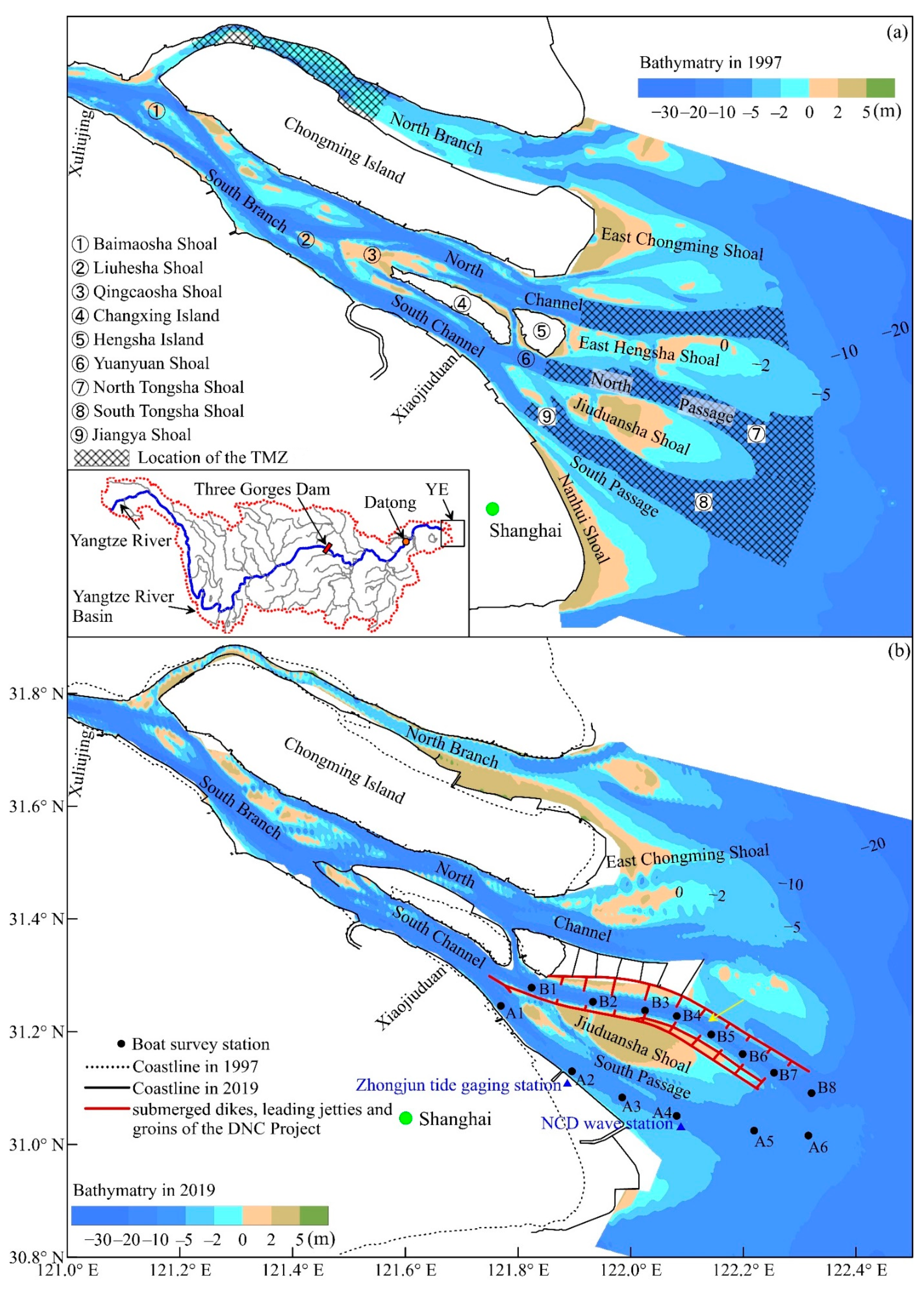

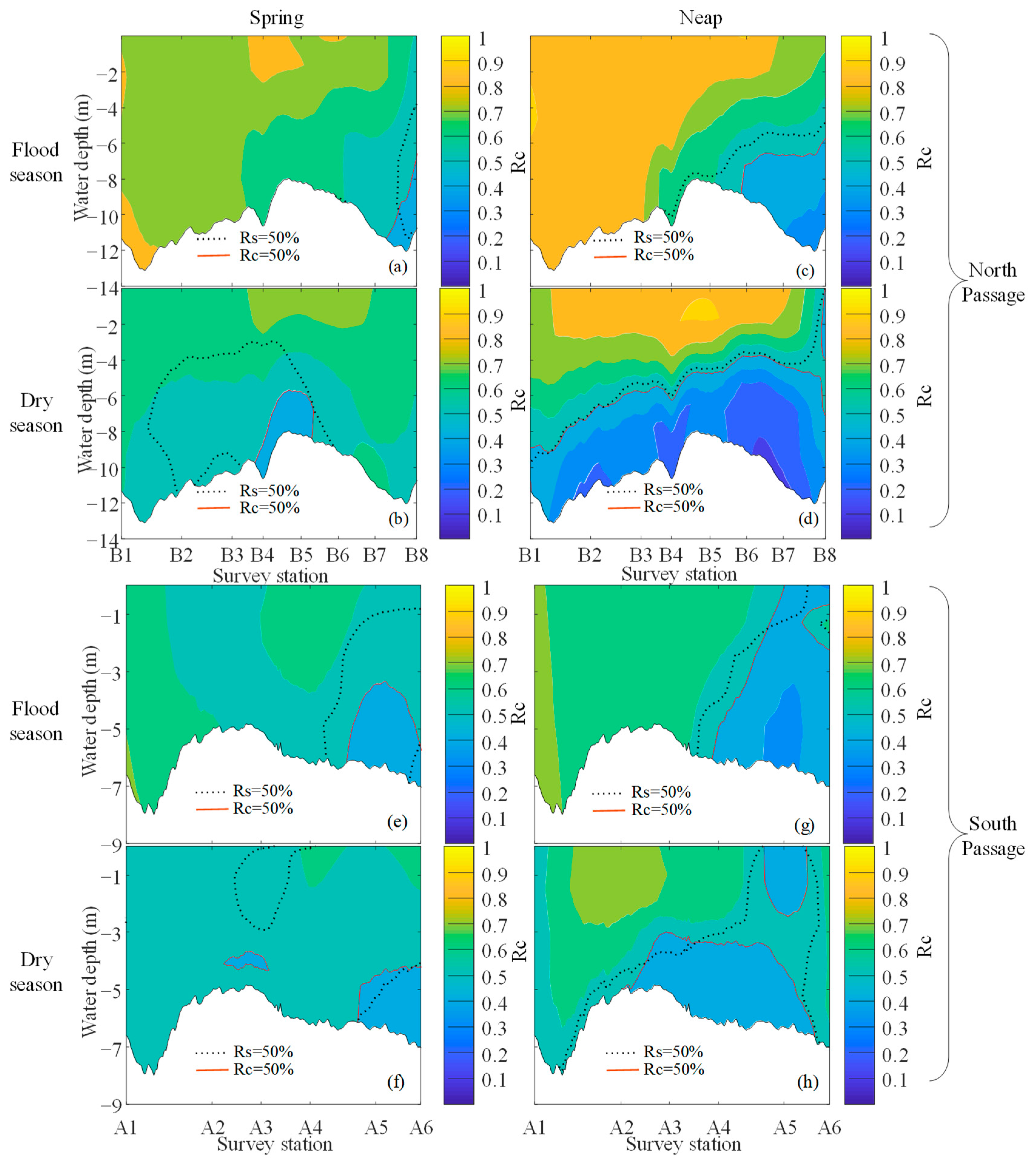

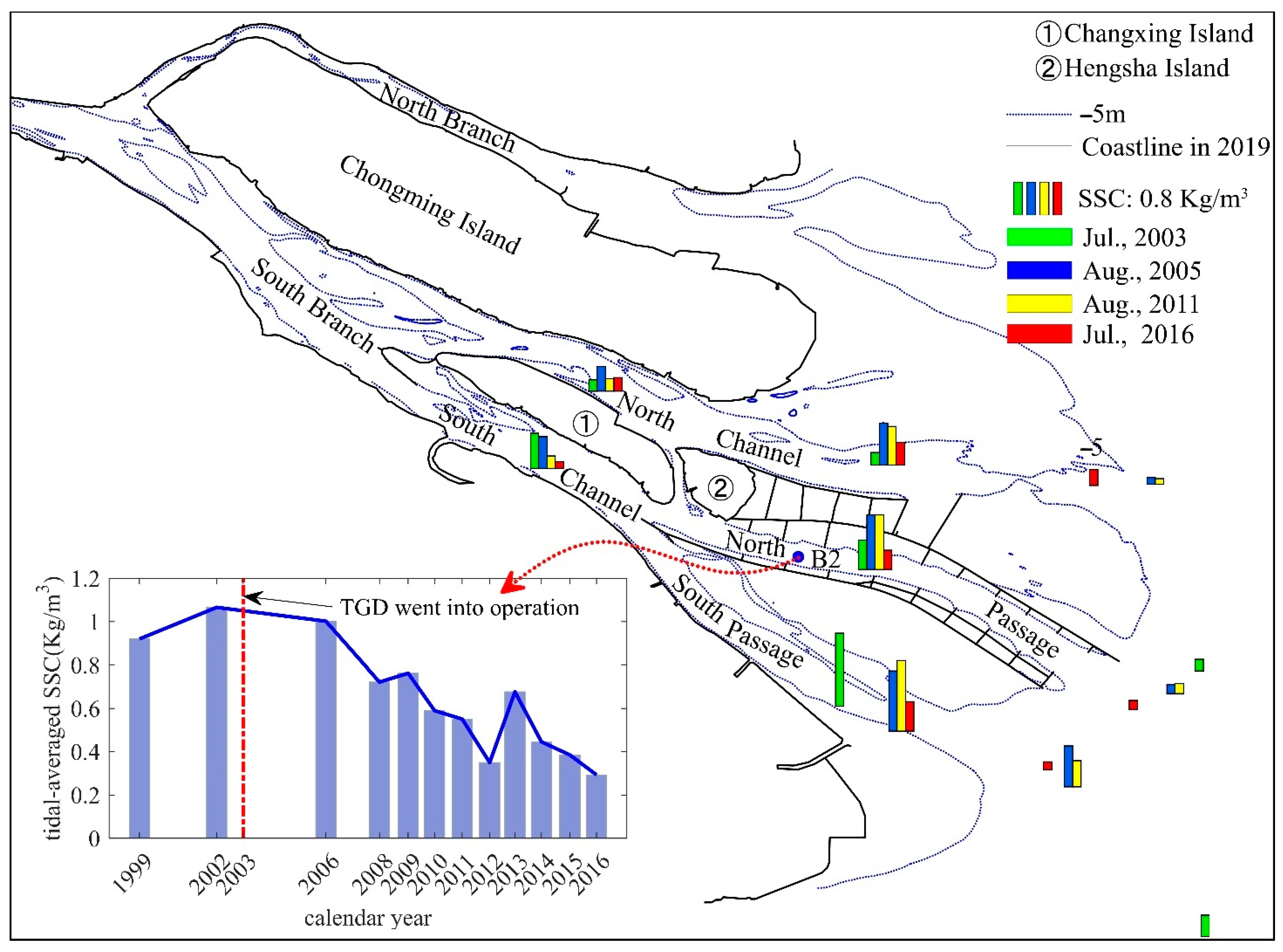


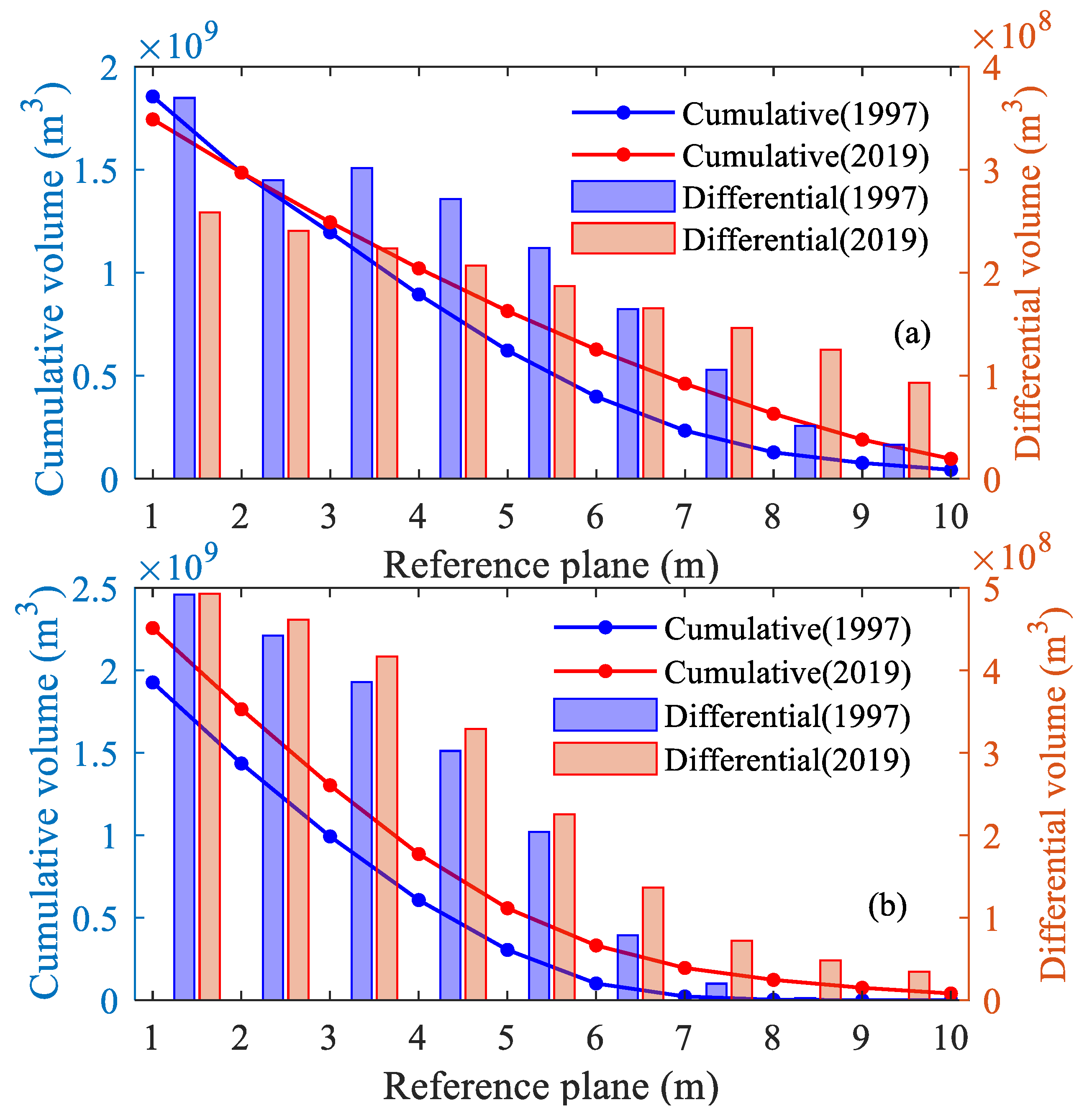

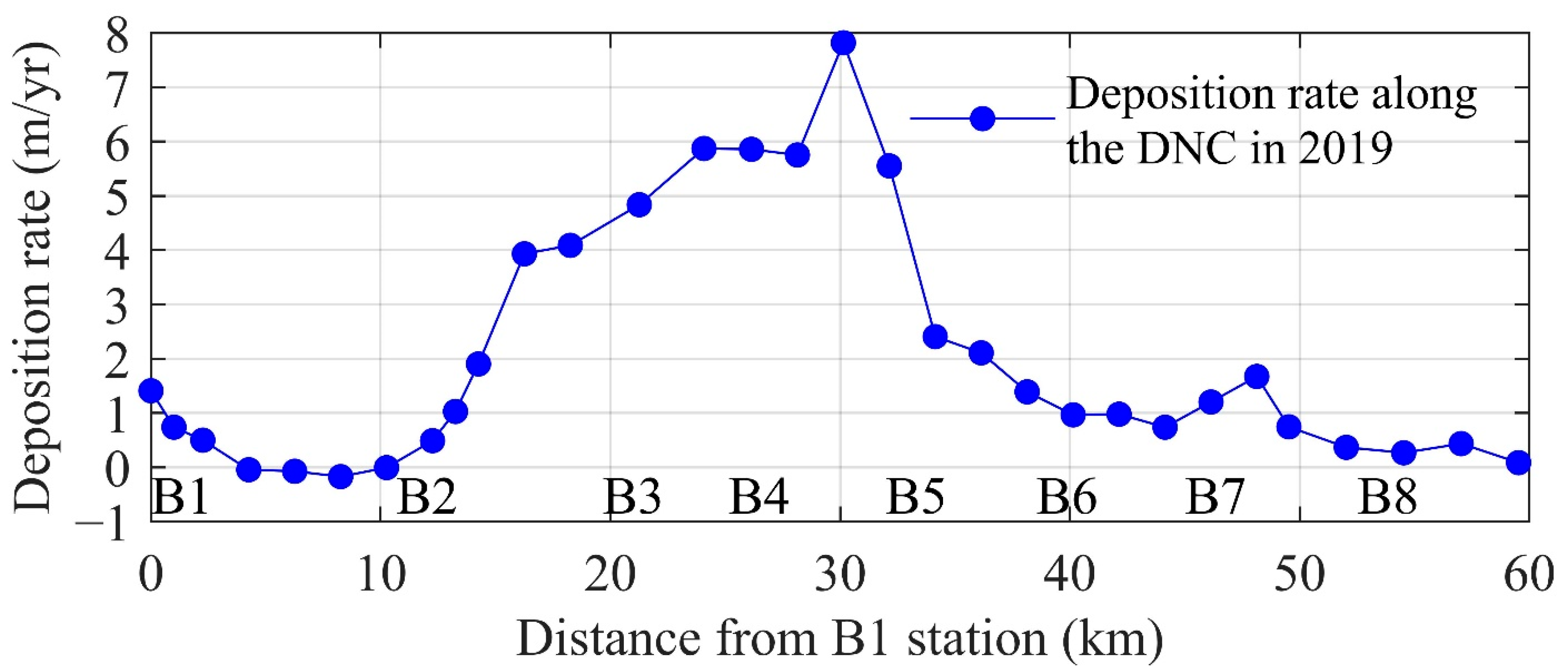
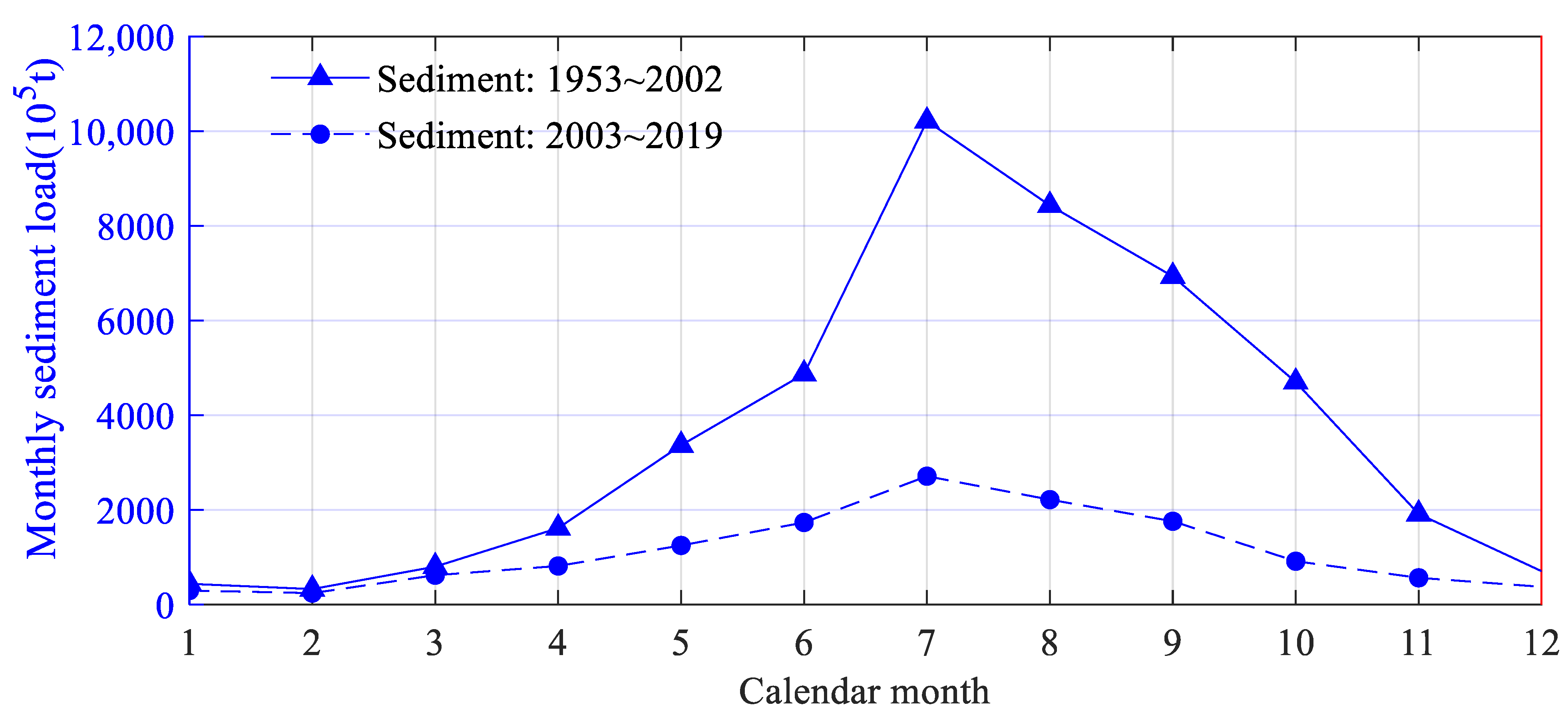
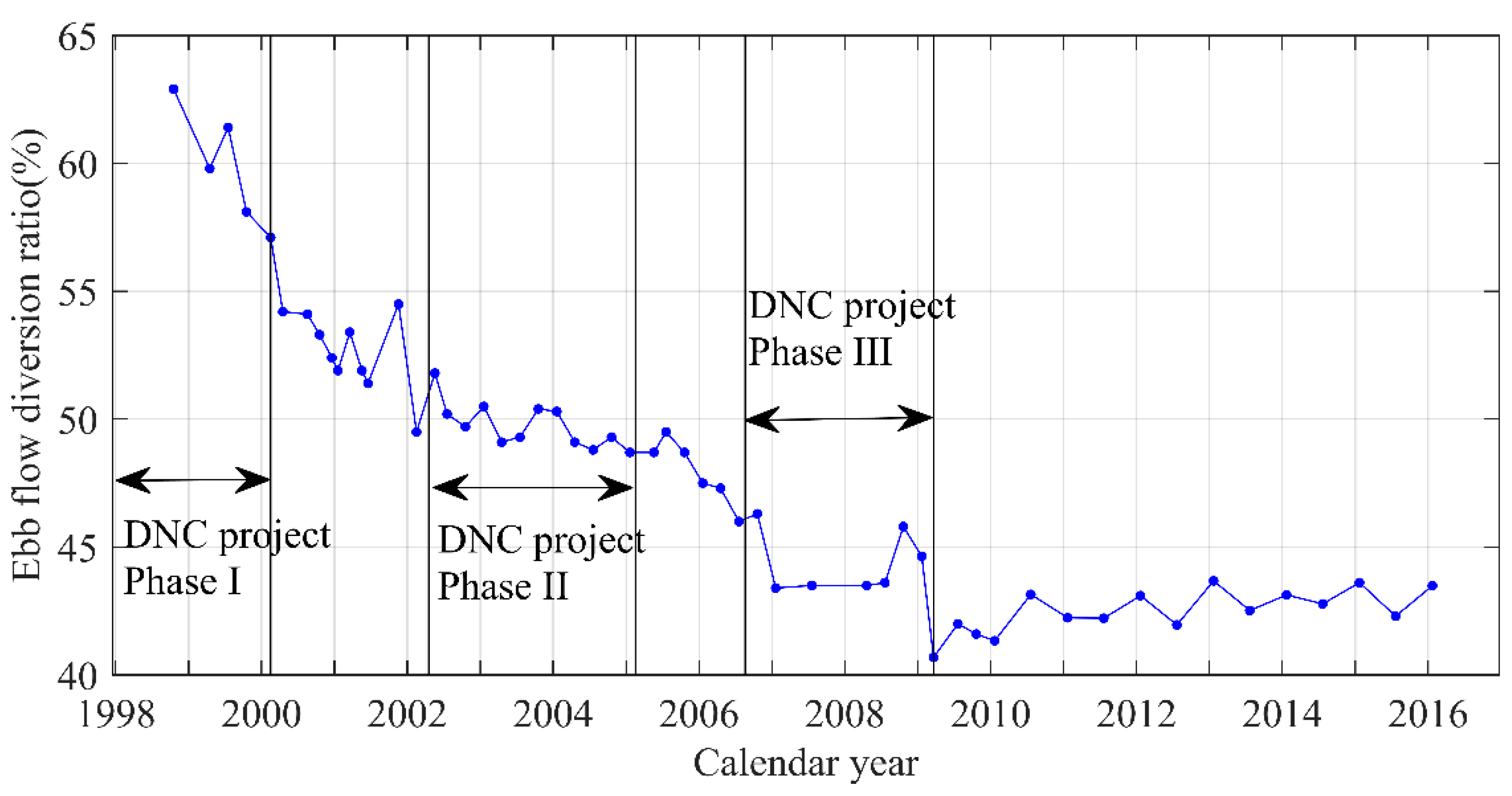
| Season | Tide | Observation Period | Discharge * (m3/s) | Observation Stations |
|---|---|---|---|---|
| flood | neap | 21 June 1999 to 22 June 1999 | 40,280 | B1, B2, B5, B7 |
| flood | spring | 9 October 1999 to 10 October 1999 | 45,100 | B1, B2, B5, B7 |
| dry | spring | 21 February 2000 to 22 February 2000 | 11,400 | B1, B2, B5, B7 |
| flood | spring | 10 August 2002 to 11 August 2002 | 48,150 | B1, B2, B4, B5, B7, B8 |
| dry | spring | 14 February 2006 to 15 February 2006 | 18,214 | A1, A2 |
| flood | spring | 13 August 2006 to 14 August 2006 | 35,578 | B1, B2, B5, B7 |
| dry | spring | 4 February 2007 to 5 February 2007 | 12,099 | A1, A2 |
| dry | spring | 21 May 2008 to 22 May 2008 | 26,100 | A1, A2 |
| flood | spring | 1 August 2008 to 2 August 2008 | 38,963 | B1–B8 |
| dry | spring | 9 February 2009 to 10 February 2009 | 11,067 | A1, A2 |
| flood | spring | 20 August 2009 to 21 August 2009 | 40,991 | B1–B8 |
| flood | spring | 5 September 2009 to 6 September 2009 | 39,407 | A2, A3, A4 |
| flood | spring | 10 August 2010 to 11 August 2010 | 61,000 | B1-B8 |
| flood | spring | 14 August 2011 to 15 August 2011 | 30,175 | A4, A5, B1–B8 |
| dry | spring | 23 February 2012 to 24 February 2012 | 15,903 | B1–B8 |
| flood | spring | 18 August 2012 to 19 August 2012 | 52,804 | A2–A5, B1–B8 |
| flood | spring | 23 July 2013 to 24 July 2013 | 39,146 | B1–B8 |
| flood | spring | 19 September 2013 to 20 September 2013 | 27,111 | A2, A3, A4 |
| dry | spring | 28 February 2014 to 29 February 2014 | 15,346 | B1-B5 |
| flood | spring | 13 July 2014 to 14 July 2014 | 43,703 | A2, A3, A4 |
| flood | neap | 20 July 2014 to 21 July 2014 | 44,286 | A2, A3, A4 |
| dry | neap | 12 February 2015 to 13 February 2015 | 12,100 | A2, A3, A4, B1–B8 |
| flood | spring | 30 July 2015 to 1 August 2015 | 41,909 | B1–B8 |
| dry | spring | 11 March 2016 to 12 March 2016 | 18,700 | A1–A6, B1–B8 |
| dry | neap | 3 March 2016 to 4 March 2016 | 18,812 | A1–A6, B1–B8 |
| flood | spring | 21 July 2016 to 22 July 2016 | 63,891 | A1–A6, B1–B8 |
| flood | neap | 27 July 2016 to 28 July 2016 | 62,020 | A1–A6, B1–B8 |
Publisher’s Note: MDPI stays neutral with regard to jurisdictional claims in published maps and institutional affiliations. |
© 2022 by the authors. Licensee MDPI, Basel, Switzerland. This article is an open access article distributed under the terms and conditions of the Creative Commons Attribution (CC BY) license (https://creativecommons.org/licenses/by/4.0/).
Share and Cite
Li, W.; Jiang, C.; Zuo, S.; Li, J. Human Intervention–Induced Changes in the Characteristics of the Turbidity Maximum Zone and Associated Mouth Bars in the Yangtze Estuary. J. Mar. Sci. Eng. 2022, 10, 584. https://doi.org/10.3390/jmse10050584
Li W, Jiang C, Zuo S, Li J. Human Intervention–Induced Changes in the Characteristics of the Turbidity Maximum Zone and Associated Mouth Bars in the Yangtze Estuary. Journal of Marine Science and Engineering. 2022; 10(5):584. https://doi.org/10.3390/jmse10050584
Chicago/Turabian StyleLi, Weihua, Chenjuan Jiang, Shuhua Zuo, and Jiufa Li. 2022. "Human Intervention–Induced Changes in the Characteristics of the Turbidity Maximum Zone and Associated Mouth Bars in the Yangtze Estuary" Journal of Marine Science and Engineering 10, no. 5: 584. https://doi.org/10.3390/jmse10050584
APA StyleLi, W., Jiang, C., Zuo, S., & Li, J. (2022). Human Intervention–Induced Changes in the Characteristics of the Turbidity Maximum Zone and Associated Mouth Bars in the Yangtze Estuary. Journal of Marine Science and Engineering, 10(5), 584. https://doi.org/10.3390/jmse10050584






